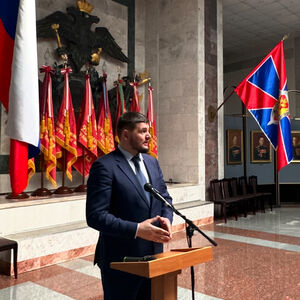43054 (687270), страница 3
Текст из файла (страница 3)
Model:
Subject group
Predicative
Object (Direct)
Object (Indirect)
homogenous
parts of
the sentence
Some examples of the symbols used in the note-taking:
MP – Member of Parliament
VIP – Very Important Person
G-7 – Group of seven
Common used abbreviations:
CIS – СНГ (Commonwealth of Independent States)
EU – European Union
RF – Russian Federation
US – United States
UK – United Kingdom
UN – ООН (United Nations Organization)
MOW – Moscow
NY – New York
LON – London
CEO – chief executive officer
JV – joint venture
FTZ – Free trade zone
P – President
VP – Vice President
I/V – investment
↑I – growth of inflation
E – employment
E – unemployment
D/B – budget deficit
Usage of contracted words:
pro – professional
demo – demonstration
info – information
Letter precision information such as proper names and geographical names is written only by means of consonants. Numeral precision information like days of a week and months is written by numbers.
e.g. ![]() – Friday, 11 – November
– Friday, 11 – November
dates: current decade – 2008 = ‘8
current century – 1995 = .95
current millennium – 1812 = .812
numbers from 1100 to 10000 is to be written by hundreds
e.g. 17H = 1700
17t = 17 thousand
17m = 17 million
17b = 17 billion
17tr = 17 trillion
Marking of semantic ties between the symbols is the most important and rather difficult point. Especially when the interpreter is voicing his notation. Speaking is marked with : after the subject group; emphasis is marked with :! (claimed, referred, accused, offered). The symbol (:) means press-conference, press-release, statement.
approval – OK
disapproval – OK
plural – sign of square; e.g. MP2 = Members of Parliament
m2 = millions
repeat = R with an arrow with the place which is repeated
> - more, < - less
↑ - growth, rise; increase; improvement; future
↓ - decrease, fall, degradation; past
∆ - state, country
l ines: → departure; E - export; address to
ines: → departure; E - export; address to
← arrival; I - import
arrival; I - import
Expression of modality:
possibility: m – may; m? – might
c – can; c? – could
doubt: ? or ?!
necessity: d (must, to be to, should) – from debere (lat.)
Comparative and Superlative degrees of Adjectives: signs of square and cube
e.g. big2 – bigger, big3 – the biggest
“Speaking” symbols:
○ – congress, meeting
X – war, conflict
This approach shouldn’t be accepted as a third language. It should be created by imagination of an interpreter. /28/
2.3 LINGUISTIC PECULIARITIES OF SIMULTANEOUS TRANSLATION
During the translation the simultaneous interpreter chooses equivalents on basis of:
-
common linguistic knowledge;
-
microcontext;
-
common background information;
-
special information.
Here is the example of choosing the equivalents in translating the fragment of the report “Patents and other industrial property titles and their licensing.”
“When technology is to be used in cooperation with a third party, whether in the form of a license, as it is the main aspect of this paper, or by merger or by taking capital investment of a third party into the company owning the technology, it is of tremendous importance to determine the value of patents and other intangible assets, in the following designated as intellectual property rights (IPR), belonging to the respective entity”.
Simultaneous translation of the fragment:
“Когда технология применяется совместно с третьей стороной, либо в форме лицензии, как в этом докладе, либо путем слияния или же вложения капитала третьей стороны в фирму, владеющую технологией, чрезвычайно важно определить стоимость патентов и прочих нематериальных активов, что в дальнейшем мы будем называть Правами на интеллектуальную собственность, принадлежащими данному субъекту”.
At first we should note that the interpreter didn’t choose the equivalents during the translation as he had chosen and remembered them earlier. These terms are “merger” – “слияние”, “intangible assets” – “нематериальные активы”, “entity” – “субъект (права)”.
At the same time there was a different interpretation and exchanging of some usual equivalents with those which do structurally and stylistically. They are “capital investment” – “инвестиция” was exchanged for “вложение капитала”, “in cooperation” – “в сотрудничестве” was exchanged for “совместно”./18/
There are main devices which were formed during the long development of oral translation and they are used in the work of simultaneous interpreter. They are speech compression, omission and addition of the material. During the oral translation from Russian into English the compression is required when there are repetitions, words of little importance or when the speaker is too fast. In order not to be behind the speaker and not to miss important segments of his speech the interpreter has to choose between lexical and syntactical equivalents which must be compressed. e.g. “На международном, национальном и местном уровнях” can be translated as “on all levels” or “on several levels”.
The ability to abridge and to condense oral speech is one of the most important abilities in the art of simultaneous translation. But, in order not to misrepresent the speaker’s idea using short words or omitting unnecessary words he is forced to decide each time what is superfluous and should be omitted.
e.g. “Госсекретарь предложил созвать конференцию”
“The secretary of state proposed a conference”
“Просмотр состоится 22 сентября”
“The showing is on September 22”
“Это было опубликовано в газете Нью-Йорк Таймс”
“This appeared in the New York Times”
Though during the translation from Russian into English the text is usually becomes shorter sometimes there are the opposite cases. It happens when the rules of English grammar and the structure of the language require addition of the article or when the complex type of tense is used. e.g. “We shall have been doing this”
The time is spending on the translation increases if the interpreter has to define more precisely or explain Russian realias.
e.g. “Днем они пошли с друзьями в ЗАГС, а вечером свадьбу справили в ресторане «Арбат»”
“In the afternoon they went to sign the marriage registry, and in the evening they had a reception in the Arbat”
Metonymy and synecdoche, as the devices of simultaneous translation, are used for the specification of common idea and the generalization of typical or concrete occurrence. When there is no exact equivalent for a definite Russian notion or when the interpreter just didn’t here some word he is often saved from failure by the substitution of the general occurrence by the concrete one and vice versa.
e.g. “зелень” (Нужно добавить зелень в суп) – “parsley and other herbs”
If the interpreter suddenly forgets the word or the idiom he can use some other synonym even less exact.
e.g. “семь пядей во лбу” – (as wise as Solomon) – “He paid him a compliment”
Antonymous inversion is another very useful device which helps to avoid a word-for-word translation when it is necessary. The possibilities of antonymous usage are very wide but they are not boundless. Context always plays a decisive role especially by the inversion of idiomatic expression.
e.g. “не иметь себе равных” – “to be second to none”
“не придавать значения” – “to overlook”
Grammatical inversion:
“И в промышленной, и в военном отношении, эти планы нашей страны…”
“Militarily and industrially, our country’s plans…”
“Их было больше”
“They prevailed”
Syntactical inversion:
“Они завоевали эту территорию”
“This territory fell to them”
The search of semantic equivalents and avoidance of a word-for-word translation are two the most important way of translation into idiomatic English.
e.g. “глубоко убеждены” – “firmly convinced”
“идти к кому-то на встречу” – “to accommodate someone”
“случайные люди в политике” – “outsiders in politics”
“белые пятна (в наших знаниях)” – “gaps”
What ever effective the devices of translation would be they don’t release the interpreter from the necessity to solve chief problem which consists in escaping over-literal rendering during the translation. They are highly dangerous to apply to specific notions and unique realias of Russian culture as they are lack of equivalents in English. The interpreter shouldn’t be limited by linguistics only in order to find better equivalents for such notions. He must study different spheres of human life in the country of the source language: its history, literature, psychology, etc. Only in this way there appears a possibility for the truth expert to fulfill the most difficult task – to interpret not just from one language into another language but from one culture into another./10/
CONCLUSION
Oral translation plays very important part in the world. Russian and foreign businessmen, scientists and politicians work side by side at different countries and therefore they need translation during commercial talks, signing of contracts and everyday communication.
During studying this work we tried to find out the problems of oral translation and the way these problems may be solved. We have done it by finding salvation to the following tasks:
-
We gave the definition to the notion “translation”;
-
We found out the difference between written and oral translation;
-
We characterized the types of oral translation;
-
We defined the problems of oral translation;
-
We found various ways and translating devices for solving those problems.
As a kind of practical activities translation is a set of actions performed by the translator while rendering ST into another language. These actions are largely intuitive and the best results are naturally achieved by translators who are best suited for the job, who are well-trained or have a special aptitude, a talent for it. Masterpieces in translation are created by the past masters of the art, true artists in their profession. At its best translation is an art, a creation of a talented, high-skilled professional.
As we have known, there two types of translation: written and oral. As the names suggest, in written translation the source text is in written form, as is the target text. In oral translation or interpretation the interpreter listens to the oral presentation of the original and translates it as an oral message in TL. As a result, in the first case the Receptor of the translation can read it while in the second case he hears it.
Oral translation falls into consecutive and simultaneous. In consecutive translation the translating starts after the original speech or some part of it has been completed. In simultaneous interpretation the interpreter is supposed to be able to give his translation while the speaker is uttering the original message.
In simultaneous interpretation the translator is expected to keep pace with the fastest speakers, to understand all kinds of foreign accents and defective pronunciation, to guess what the speaker meant to say but failed to express due to his inadequate proficiency in the language he speaks.
In consecutive interpretation he is expected to listen to long speeches, taking the necessary notes, and then to produce his translation in full or compressed form, giving all the details or only the main ideas.
Sometimes the interpreter is set a time limit to give his rendering, which means that he will have to reduce his translation considerably, selecting and reproducing the most important parts of the original and dispensing with the rest. This implies the ability to make a judgement on the relative value of various messages and to generalize or compress the received information. The interpreter must obviously be a good and quickwitted thinker./14/
Appendices to the course paper
“Problems of oral translation”

| Source text | Written translation | Simultaneous translation |
| Mr. President! Our gratitude and appreciation are due to the retiring President, Mr. Fanfani, for his notable contribution to the work of the preceding session. | Г-н председатель! Уходящий в отставку председатель, г-н Фанфани, заслуживает нашей благодарности и высокой оценки за тот значительный вклад, который он внес в работу предыдущей сессии Ассамблеи. | Г-н председатель! Мы глубоко признательны бывшему председателю, г-ну Фанфани, за значительный вклад в работу прошлой сессии. |
| In congratulating you, Sir, on your elevation to the Presidency of this Assembly, the New Zealand delegation pledges its cooperation with you in your demanding duty of attempting to channel in a positive direction the authority which the Assembly possesses. | Поздравляя Вас, г-н председатель, по поводу Вашего избрания на пост председателя настоящей сессии Ассамблеи, делегация Новой Зеландии обещает Вам сотрудничать с Вами при выполнении Вами ответственной задачи, которая заключается в том, чтобы попытаться направить работу Генеральной Ассамблеи в русло позитивных решений. | Поздравляя Вас с избранием на пост председателя Ассамблеи, делегация Новой Зеландии обещает сотрудничать с Вами в выполнении Вашей задачи - направить в нужное русло авторитет Ассамблеи. |
| At a time when the problems of Asia are of such primary concern, it is altogether appropriate, as many have remarked before, that it should be the distinguished son of Asia who presides over our deliberations. | В период, когда проблемы Азии вызывают такую глубокую тревогу, вполне законно, как отмечали многие ораторы, выступавшие до меня, что нашей работой руководит уважаемый сын Азии. | Сейчас, когда проблемы Азии вызывают столь большую тревогу, законно, как уже отмечали многие ораторы, что нашей работой руководит выдающийся сын Азии. |
| 184 syllables | 256 syllables | 168 syllables |

















